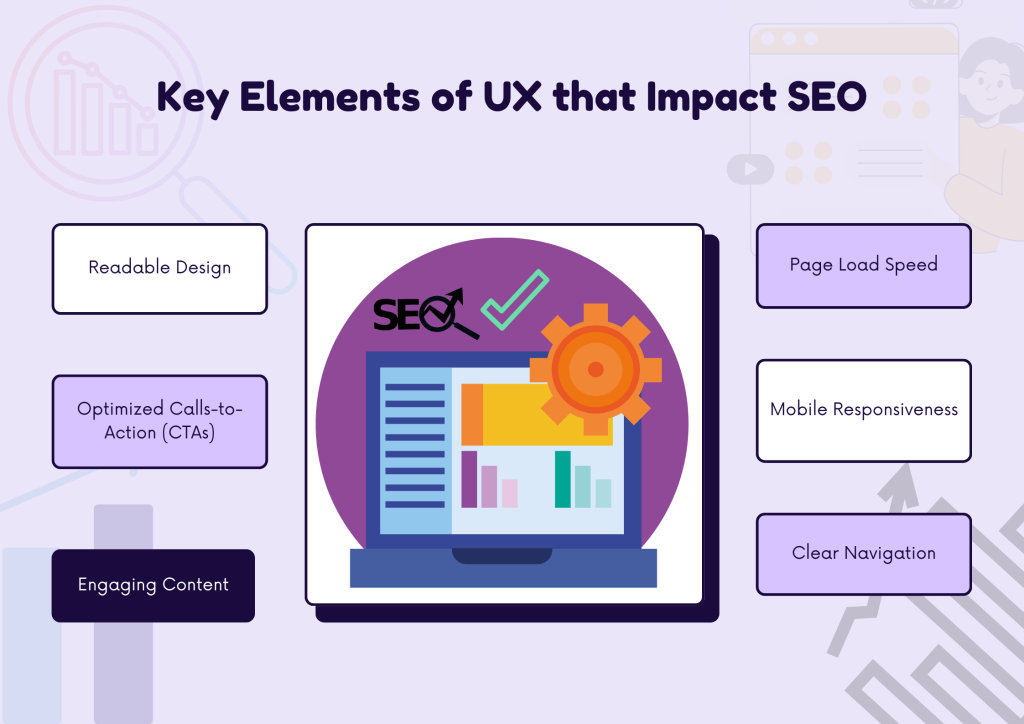In the evolving landscape of digital marketing, UX and SEO have become indispensable elements for success. While SEO focuses on optimizing a website for search engines, user experience (UX) ensures that visitors enjoy a smooth, engaging interaction with your site. Together, they can significantly boost website ranking and user engagement.
Why UX Matters for SEO
Search Engines Prioritize User Satisfaction
Google and other search engines aim to deliver high-quality results that satisfy users. Websites offering a great user experience are more likely to rank higher, as these sites meet search engine standards for value and usability.
Lower Bounce Rates
A well-designed website encourages users to stay longer and explore more pages. Reduced bounce rates signal search engines that your site provides value, positively impacting SEO rankings.
Mobile Friendliness
With the growth in mobile usage, having a mobile-friendly site is essential for UX and SEO. Google’s mobile-first indexing gives priority to sites optimized for mobile, which directly influences your rankings.
How User Experience Impact On SEO

Page Load Speed
Users expect a website to load within 2-3 seconds; anything longer can lead to higher bounce rates and a drop in SEO ranking. Use tools like Google PageSpeed Insights to identify and resolve speed issues, ensuring both UX and SEO are optimized.
Mobile Responsiveness
Mobile responsiveness impacts both user experience and SEO. Responsive design adjusts content for different screen sizes, enhancing mobile-friendliness and usability across all devices.
Clear Navigation
A user-friendly site structure with clear, intuitive navigation helps visitors quickly find the information they need. Easy-to-use menus and internal links not only improve user experience but also assist search engines in crawling and indexing your site more efficiently.
Engaging Content
High-quality content that is informative and engaging keeps users on your site longer, enhancing dwell time. This signals to search engines that your site provides value. Use headings, bullet points, and images to make content more scannable and appealing.
Optimized Calls-to-Action (CTAs)
Effective CTAs guide users to take specific actions, such as signing up or making a purchase. Well-placed CTAs can boost user engagement and contribute to a positive UX.
Readable Design
A clean, readable design with appropriate font sizes and colors ensures that users can easily read your content. Avoid cluttered layouts and use white space to improve readability and focus, enhancing both UX and SEO.
Benefits of Combining UX and SEO
Better Search Engine Rankings
An optimized UX encourages higher user engagement, lower bounce rates, and longer sessions—all of which boost search engine ranking.
Increased User Engagement
Sites with a positive user experience encourage users to stay longer and interact with more content, improving engagement metrics.
Higher Conversion Rates
A well-designed UX can increase conversion rates, whether through purchases, form submissions, or newsletter signups. A seamless experience helps guide users toward desired actions.
Tools to Boost Website Ranking
Enhancing user experience (UX) is vital for boosting website ranking with SEO. By utilizing tools like Google Analytics, Google PageSpeed Insights, and Hotjar, you can measure user experience impact in SEO. These tools provide actionable insights into site performance, user behavior, and areas to optimize. With improved UX and SEO, you’ll create a more engaging website that ranks higher in search results, drawing in and retaining more visitors.

- Google Analytics: Track user behavior on your site, such as session duration and bounce rate, to identify areas for UX improvement.
- Google PageSpeed Insights: Measure and optimize load speed on both desktop and mobile devices.
- Hotjar: Analyze heatmaps and user interactions to see where users click and scroll most, allowing for UX adjustments that enhance user engagement.
For a deeper understanding of how user experience and SEO can transform a website’s visibility and usability, explore this guide on the importance of SEO in web development. It dives into how SEO aligns with user-centered design to create websites that both rank well and provide seamless user experiences, helping maximize engagement and performance.
Conclusion
UX and SEO are deeply intertwined, delivering a positive experience that keeps visitors engaged and improves your site’s ranking. By focusing on UX elements like page speed, mobile-friendliness, and clear navigation, you can enhance both user satisfaction and SEO performance.


Way cool! Some extremely valid points! I appreciate
you penning this write-up plus the rest of the site is extremely
good.
You could definitely see your skills within the article you write.
The sector hopes for more passionate writers such as you
who aren’t afraid to mention how they believe. Always go after your heart.
Cool blog! Is your theme custom made or did you download it
from somewhere? A design like yours with a few simple tweeks
would really make my blog shine. Please let me know where you
got your design. Thanks a lot
You could certainly see your enthusiasm within the article
you write. The sector hopes for more passionate writers like you who aren’t afraid
to say how they believe. All the time go after your heart.